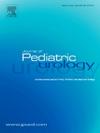膨胀剂治疗儿童和青少年尿管失禁。
IF 1.9
3区 医学
Q2 PEDIATRICS
引用次数: 0
摘要
背景:可导尿的大陆通道(CCC)提供了尿失禁时,尿道导尿是不可行的手段。然而,一些患者出现口失禁,需要进一步干预。本研究的目的是评估内镜下注射膨化剂(Deflux©)作为一种微创治疗CCC型尿失禁的有效性,并探讨影响儿童队列结果的患者特异性变量。方法:回顾性回顾我院儿科泌尿外科手术登记,以确定2001年至2021年间我院所有接受CCC和至少一种填充剂治疗造口瘘的患者。术后3个月评估术后结果,此后每年评估一次。结果:共有21名儿童和青年成人纳入CCC适应症,包括神经源性膀胱(n = 13),膀胱或泄殖腔外翻(n = 5)和其他情况(n = 3)。最常见的通道类型是阑尾膀胱造口(n = 7),其次是Monti管(n = 5)、螺旋Monti管(n = 3)、输尿管管(n = 3)和其他类型(n = 3)。首次EI的中位年龄为9.7岁(IQR为8.2-15.1),中位随访时间为4.0年(IQR为1.2-6.7)。随访时,11例患者(52%)达到尿失禁。9例患者(43%)因尿失禁最终需要手术矫正,3例患者因其他原因。没有患者(0%)从bbb101注射中获得长期益处。结论:内镜注射提供了一种微创的选择,可以被认为是治疗CCC型尿失禁的一线方法。然而,对于一些患者,手术矫正仍然是必要的。在我们的材料中,再注射是无效的。本文章由计算机程序翻译,如有差异,请以英文原文为准。
Bulking agent treatment of incontinent catheterizable channels in pediatric patients and young adults
Background
Catheterizable continent channels (CCC) provide means for urinary continence when urethral catheterization is not feasible. However, some patients present with stomal incontinence warranting further interventions. The purpose of this study is to evaluate the effectiveness of endoscopic injection (EI) of bulking agent (Deflux©) as a minimally invasive treatment for CCC incontinence and to explore patient-specific variables influencing outcomes in a pediatric cohort.
Methods
Hospital's pediatric urology procedure registry was retrospectively reviewed to identify all patients with a CCC and at least one EI of bulking agent for the leakage of the stoma at our institution between 2001 and 2021. The postoperative outcomes were assessed three months after the procedure and annually thereafter.
Results
A total of 21 children and young adults were included with CCC indications including neurogenic bladder (n = 13), bladder or cloacal exstrophy (n = 5) and other conditions (n = 3). The most common channel type was appendicovesicostomy (n = 7) followed by Monti tube (n = 5), spiral Monti (n = 3), ureter (n = 3), and other types (n = 3). The median age at first EI was 9.7 years (IQR 8.2–15.1) with a median follow-up time of 4.0 years (IQR 1.2–6.7). At follow-up, 11 patients (52 %) achieved continence. Surgical correction was ultimately required in nine patients (43 %) due to incontinence and in three patients for other reasons. No patient (0 %) experienced long term benefit from >1 injections.
Conclusion
Endoscopic injections offer a minimally invasive option and can be considered a first-line approach for treating CCC incontinence. However, surgical correction remains necessary for some patients. In our material, re-injections were ineffective.
求助全文
通过发布文献求助,成功后即可免费获取论文全文。
去求助
来源期刊

Journal of Pediatric Urology
PEDIATRICS-UROLOGY & NEPHROLOGY
CiteScore
3.70
自引率
15.00%
发文量
330
审稿时长
4-8 weeks
期刊介绍:
The Journal of Pediatric Urology publishes submitted research and clinical articles relating to Pediatric Urology which have been accepted after adequate peer review.
It publishes regular articles that have been submitted after invitation, that cover the curriculum of Pediatric Urology, and enable trainee surgeons to attain theoretical competence of the sub-specialty.
It publishes regular reviews of pediatric urological articles appearing in other journals.
It publishes invited review articles by recognised experts on modern or controversial aspects of the sub-specialty.
It enables any affiliated society to advertise society events or information in the journal without charge and will publish abstracts of papers to be read at society meetings.
 求助内容:
求助内容: 应助结果提醒方式:
应助结果提醒方式:


